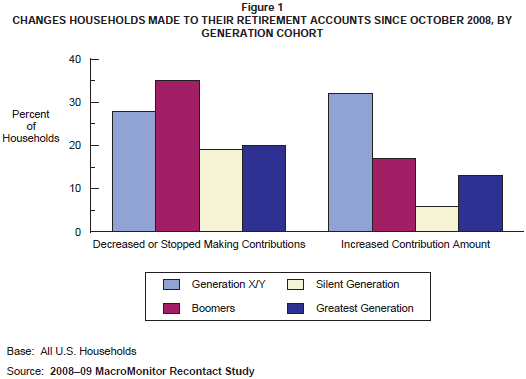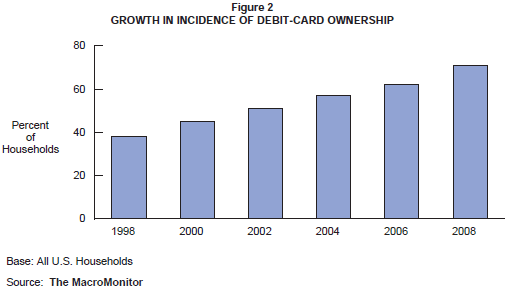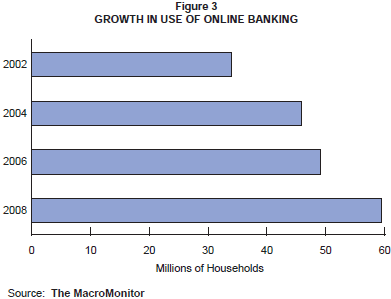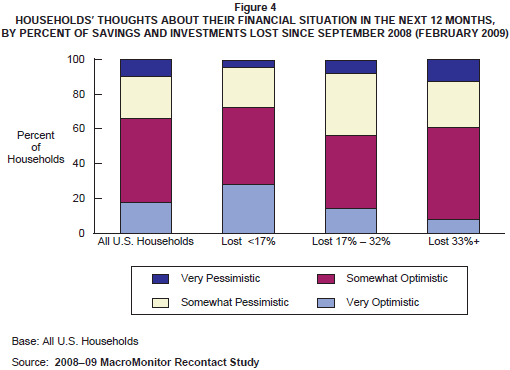MacroMonitor Market Trends April–May 2009
MacroMonitor Market Trends highlights topical news and trends of interest to you and your colleagues. If you would like more information about the items in the newsletter or would like to discuss other ways that we can assist you in your research and marketing efforts, please contact us.
In this issue:
How Will the Market Downturn Affect Young Investors?
Industry and media pundits have questioned whether the recent market downturn will drive today's youngest investors to the sidelines, possibly leaving many of them there forever, much as the Great Depression drove many young investors (we now call them the "Greatest Generation") to the sidelines in another era. The current downturn will not likely completely define the investing perspectives of older households—even if it did redefine their net worth. But for many younger households, with much less exposure to the financial markets, this downturn represents much of what they know about investing. For Gen X/Y households in particular, the downturn has eroded, on average, 31% of their savings and investments since October 2008.
In our 2008–09 MacroMonitor Recontact survey of February 2009, we asked respondents what changes they had made to their retirement accounts since September 2008. Although 28% of Gen X/Y households reported that they had stopped contributing or decreased their contributions, 32% had actually increased their contribution amount. By comparison, 35% of Boomers had stopped contributing or decreased their contributions; only 17% had increased their contribution amount (see Figure 1). These early data show that younger households have not completely abandoned the notion of investing; in fact, the data indicate that younger households may be taking advantage of relatively low equity prices and long investment horizons. This young generation benefits from a historical understanding of equity and housing markets and a wealth of available information about financial products and markets that were unavailable to its counterpart after the Great Depression.

In addition, data from the 2008–09 MacroMonitor show that only 44% of Gen X/Y households plan to rely on Social Security for their retirement. In contrast, 54% of Boomers, 71% of the Silent Generation, and 80% of the Greatest Generation plan to rely on it. The U.S. Social Security system was born out of the Great Depression, and for many young people postcrisis, it created a disincentive to invest in the financial markets going forward. Generation X/Y, however, has not bought into relying for their retirement on the Social Security system—a system that for many years now people have deemed unsustainable in the future.
Certainly, households of all generations will be affected psychologically by the current financial downturn with regard to how they manage their finances moving forward. Early indications show, however, that young households of today are not as likely to turn away from investing as were many of their young counterparts after the Great Depression.
Debit Cards and Online Banking Grow in New Era of Thrift
Going forward, past the current financial crisis, financial institutions that focus on making the conduct of day-to-day financial transactions more convenient and stress free will be well poised to capture a large portion of the retail financial market in the future. With their savings slashed, many U.S. families are opting to live below their means. (The savings rate is already going up, according to recent government reports.) This financial strategy will most likely continue even after the end of the recession. Hence, day-to-day money-management and budgeting tools will now play a much more significant role for households than they did in the past when easy credit and conspicuous consumption ruled the day. We expect two transaction media to rise in popularity as households seek more control over their finances: debit cards and online banking.
Data from our MacroMonitor surveys are a harbinger of future growth for debit cards. In 2002, just half of all households owned a debit card. By 2008, at least seven in ten households own at least one of these cards (see Figure 2). More owners of debit cards are now using this transaction vehicle in a wider array of retail venues. More than eight in ten owners used their debit card at a supermarket, grocery store, restaurant, or fast-food place in 2008, in comparison with 73% in 2002. Nearly seven in ten used their card in 2008 at a gas station or convenience store versus 59% in 2002. Even the Internet is seeing more debit-card transactions: 33% of owners used their debit card to make an online purchase in 2008.

Similarly, online banking is well on its way to becoming the norm for households for managing their depository accounts. Nearly 60 million U.S. households now use online banking: 21% more than in 2006. The convenience of online services such as bill payment and the increased accessibility of the services have moved two-thirds of households with Internet access to use online banking. By comparison, just one-fifth of households with Internet access use online investing or other online financial services in 2008.

Institutions that can fully support households' transaction needs and conveniently facilitate the management of their finances will be best positioned to serve consumers coming out of the current financial crisis. Institutions that offer extensive debit-card networks and secure online transactions are likely to succeed in expanding their customer base and in finding cross-selling opportunities when the economy finally turns around and households rebuild their assets.
Households Remain Surprisingly Optimistic
Despite being inundated with fear-provoking news and ominous assessments of skyrocketing unemployment, Ponzi schemes, retreating consumer confidence in financial institutions and the economy, record-high home-foreclosure rates, and the potential failure of the banking industry, many consumers remain surprisingly optimistic about their own financial situation. According to data from the 2008–09 MacroMonitor Recontact survey that we fielded in February 2009, two in three households are somewhat (48%) or very (18%) optimistic about their household's financial situation in the next 12 months. Understandably, the degree to which a household feels optimistic about its situation going forward is based largely on whether the household has been affected by the ongoing financial meltdown. As Figure 4 shows, households that lost the least amount of their savings and investments as a result of the events of September 2008 (in this case, fewer than 17%) remain the most optimistic of all households: Almost three in ten are very optimistic about their situation in the next 12 months. Households that lost the most value from their savings and investments (33% or more), by contrast, are the most pessimistic: 13% are very pessimistic about their financial situation in the next 12 months; 26% are somewhat pessimistic.

It is interesting to note that a majority of respondents are also optimistic about their employment. In February 2009, almost 60% of all households were not concerned that the current economic situation would affect a head of household's job in the next 12 months; just one in five households were very concerned that it would. Although their level of pessimism is very high (40% of households are concerned about a job loss), the fact that 60% are optimistic seems encouraging.
The unexpected level of optimism that we found among respondents perhaps points to an underlying resiliency that has received far less media coverage than the dire pronouncements of gloom and doom. Our data suggest that financial consumers may be weathering the economic storm somewhat better than the media report.